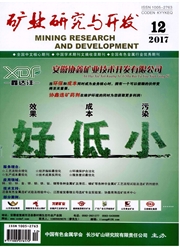

 中文摘要:
中文摘要:
地下采矿方法优选是矿床开采设计中的核心内容之一,是一个典型的多目标决策问题。以某铅锌矿床为例,首先根据矿床形态、产状和地质技术条件初选出几种技术上可行的采矿方法,并综合考虑技术经济指标、资源利用指标、劳动生产指标、安全指标、环境指标,建立了采矿方法优选的层次结构指标体系。然后采用极差变换原理和模糊数学中的优先关系二元对比法分别进行了定量指标标准化和定性指标隶属度矩阵的构建。运用模糊层次分析法(FAHP)建立了影响指标的主观权重矩阵,利用熵权法(EM)计算出影响指标的客观权重矩阵。提出主客观组合赋权法的基本原理,基于灰色相关分析法(GRA)确定了主客观组合权重矩阵,最终依据模糊综合评价法(FCE)确定了该矿山的最优采矿法为分段凿岩阶段空场嗣后充填法。
 英文摘要:
英文摘要:
Optimal selection of underground mining method is a significant research in mine design, which is regarded as a multi-objective decision problem. Taking a lead-zinc deposit as a reaearch example, several feasible mining methods were primarily selected according to the shape and attitude of de- posit, as well as the geological condition. Besides, a hierar- chical index system for optimal selection of mining methods was established through comprehensively considering the in- dexes including technical economy, resource utilization, la- bor productivity, safety and environment. Then, the quanti- tative index standardization and the membership degree ma- trix of qualitative index were constructed by range transfor- mation principle and two-elements contrasting method of precedence relationship in fuzzy mathematics. The subjective weight matrix influencing indexes was built by FAHP, and the objective weight matrix influencing indexes was calculat- ed by EM. In addition, a new fundamental principle for sub- jective-objective weighting method was put forward, and the subjective-objective weight matrix was determined based on the GRA. Finally, the sublevel drilling and open stoping with backfill was determined as the best mining method by FCE.
 同期刊论文项目
同期刊论文项目
 同项目期刊论文
同项目期刊论文
 期刊信息
期刊信息
